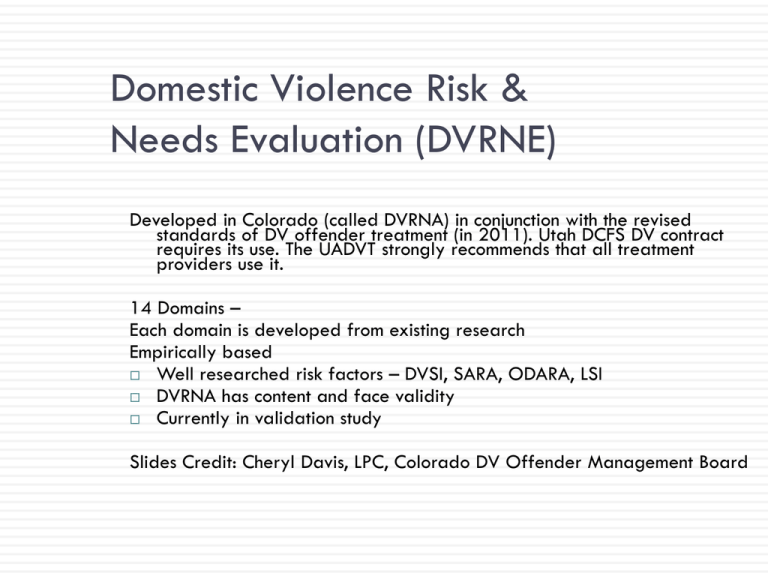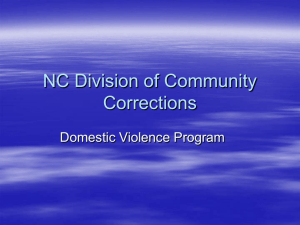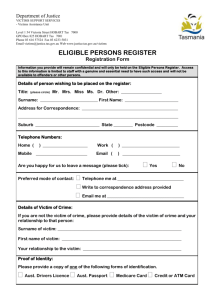History - Utah Association for Domestic Violence Treatment
advertisement

Domestic Violence Risk & Needs Evaluation (DVRNE) Developed in Colorado (called DVRNA) in conjunction with the revised standards of DV offender treatment (in 2011). Utah DCFS DV contract requires its use. The UADVT strongly recommends that all treatment providers use it. 14 Domains – Each domain is developed from existing research Empirically based Well researched risk factors – DVSI, SARA, ODARA, LSI DVRNA has content and face validity Currently in validation study Slides Credit: Cheryl Davis, LPC, Colorado DV Offender Management Board Automatic Level Placement Three levels of risk, needs and differential treatment Significant Risk Factors and Critical Risk Factors that indicate a need for initial placement in treatment at Level B or C because they are more strongly associated with reoffense. These risk factors have significant research support. Annotated DVRNA is available at UADVT.org Scores and level of care can be adjusted upward during the course of treatment SCORING Each Domain of the DVRNA has a maximum score of one point. There are 14 Domains on the DVRNE Therefore the maximum score of 14 Scoring Manual (Colorado) available at UADVT.org Strict adherence to scoring – maintain fidelity, integrity of instrument Encourage training only by UADVT approved trainers Victim Safety Concerns are Paramount. Do not score information obtained from the victim that is not in the public domain without written consent. Domain A: Prior domestic violence related incidents Prior domestic violence related incidents (Any of the following are Significant Risk Factors that indicate initial treatment placement in LEVEL B) (Ventura and Davis 2004; ODARA, 2005). This domain applies only to adult criminal history. 1. Prior domestic violence conviction (ODARA, 2005) Critical Risk Factor that indicates initial treatment placement in LEVEL C 2. Violation of an order of protection (B-SAFER, 2005; Kropp & Hart 2008; DVSI, 1998) 3. Past or present civil domestic violence related protection orders against offender. 4. Prior arrests for domestic violence (Ventura & Davis, 2004) 5. Prior domestic violence incidents not reported to criminal justice system (Cattaneo & Goodman, 2003). Domain B: Drug or alcohol abuse Any of the following are Significant Risk Factors that indicate initial treatment placement in LEVEL B at a minimum. 1. Substance abuse/dependence within the past 12 months (Kropp & Hart, 2008; B-SAFER, 2005; Weisz, et al., 2000; ODARA, 2005; Cattaneo & Goodman, 2003) 2. History of substance abuse treatment within the past 12 months (Kropp & Hart, 2008; Klein, 2008) or two or more prior drug or alcohol treatment episodes during lifetime (DVSI, 1998) 3. Offender uses illegal drugs or illegal use of drugs (Campbell, 1995) Domain B continued The DSM V refers to “substance dependence” as a pattern of repeated self-administration that can result in tolerance, withdrawal, and compulsive drug-taking Domain C: Mental health issues Any of the following are Significant Risk Factors that indicate initial treatment placement in LEVEL B at a minimum. 1. Existing DSM diagnosis (excluding v codes) 2. Personality disorder with anger, impulsivity, or behavioral instability (Kropp & Hart, 2008; B-SAFER, 2005) 3. Severe psychopathology (Gondolf, 2007; Hare 1998) 4. Recent psychotic and/or manic symptoms (Kropp & Hart, 2008) 5. Psychological/psychiatric condition currently unmanaged 6. Noncompliance with prescribed medications and mental health treatment 7. Exhibiting symptoms that indicate the need for a mental health evaluation Domain D: Suicidal/homicidal 1. Serious homicidal or suicidal ideation/intent within the past year (Kropp & Hart, 2008) (This is a Critical Risk Factor that indicates initial treatment in Level C) “Serious” as defined in the SARA means that the ideation is experienced as persistent and intrusive or involves high lethality methods; or that the level of intent is moderate to high. 2. Ideation within the past 12 months (Kropp & Hart, 2008; B-SAFER, 2005) 3. Credible threats of death within the past 12 months (Kropp & Hart, 2008) “Credible” as defined in the SARA means that the threats were perceived as credible by the victim. 4. Victim reports offender has made threats of harming/killing her (female victims in heterosexual relationships (Campbell, 2008) Jacquelyn Campbell’s work cited in this document refers to her work on femicide and only female victims in heterosexual relationships. Suicidal/Homicidal UADVT recommends use of the Columbia Suicide Severity Rating Scale (CSSRS) http://www.cssrs.columbia.edu/ Domain E: Use and/or threatened use of weapons in current or past offense or access to firearms 1. Gun in the home in violation of a civil or criminal court order (Vigdor & Mercy, 2006) (This is a Critical Risk Factor that indicates initial treatment in Level C) 2. Use and/or threatened use of weapons in current or past offense (Kropp & Hart, 2008; Azrael & Hemenway, 2000) (This is a Critical Risk Factor that indicates initial treatment in Level C) 3. Access to firearms (VPC, 2007; Paulozzi et al. 2001; Mitchell & Carbon, 2002; Mitchell & Carbon, 2002; Campbell, 2003; Saltzman, et al., 1992; Klein, 2008) Personal ownership of a firearm, living in a household with a firearm, access to a firearm, etc. Domain F: Criminal history – nondomestic violence (both reported and unreported to criminal justice system). This domain applies only to adult criminal history. 1. Offender was on community supervision at the time of the offense (DVSI, 1998) (This is a Critical Risk Factor that indicates initial treatment in Level C) 2. Offender has a prior arrest for assault, harassment, or menacing (DVSI, 1998; Buzawa, et al., 2000; Ventura & Davis, 2004). If there have been two or more arrests, it is a Significant Risk Factor that indicates initial treatment in Level B at a minimum. 3. Prior nondomestic violence convictions (DVSI, 1998; Klein, 2008; ODARA, 2005; Ventura & Davis, 2004) Note: If the offender was scored on Domain B2, only for 2 or more prior drug or alcohol treatment episodes during their lifetime, DO NOT also score any related previous DUIs here. DOMAIN F CONTINUED 4. Past violation(s) of conditional release or community supervision (Kropp & Hart, 2008; B-SAFER, 2005; ODARA, 2005) 5. Past assault of strangers, or acquaintances (Kropp & Hart, 2008; Weisz, et al., 2000; B-SAFER, 2005) 6. Animal cruelty/abuse (Humane Society, 2007; Volant et al., 2008; Ascione, 1998; Faver & Strand, 2003, Ascione, 2007; Ascione, et al., 2007) DOMAIN G: Obsession with the victim 1. Stalking or monitoring (Campbell, 2003; Block, Campbell, & Tolman, 2000) 2. Obsessive jealousy with the potential for violence, violently and constantly jealous, morbid jealousy (Wilson & Daly, 1992; Hilberman & Munson 1978; Campbell, 2003) DOMAIN H: Safety concerns 1. Victim perception of safety/victim concerned for safety (Gondolf, 2001; Klein, 2008; Buzawa, et al., 2000; ODARA, 2005; Heckert & Gondolf, 2004) 2. Victim (female victim in heterosexual relationship) believes offender is capable of killing her (Campbell, 1995) 3. Offender controls most of victim’s daily activities (Campbell, 1995; Block, Campbell, & Tolman 2000; Tjaden & Thoennes, 2000) 4. Offender tried to “choke” victim (Campbell, 2008). Although the medical terminology is “strangle”, victims more readily identify with the word choke when reporting abuse. DOMAIN H CONTINUED 5. Physical violence is increasing in severity (Kropp & Hart, 2008; B-SAFER, 2005) 6. Victim forced to have sex when not wanted (Campbell, 1995) 7. Victim was pregnant at the time of the offense and offender knew this (Martin et al., 2001; ODARA, 2005) 8. Victim is pregnant and offender has previously abused her during pregnancy. (Gazmararian, 1996; Martin et al., 2001) Reminder: information obtained from the victim should not be scored unless it is in the public domain without written consent. DOMAIN I: Violence and/or threatened violence toward family members including child abuse Any incidents scored in Domain F (Criminal History) should not be scored here. Does not include intimate partners. 1. Current or past DCFS/CPS case (voluntary services aren’t scored) 2. Past assault of family members (Kropp & Hart, 2008) 3. Children were present (in the vicinity) during any offense (DVSI, 1998) DOMAIN J: Attitudes that support or condone spousal assault 1. Explicitly endorses attitudes that support or condone intimate partner assault. 2. Appears to implicitly endorse attitudes that support or condone intimate partner assault. E.g., minimizing, denying, patriarchy, misogyny, etc. (Kropp & Hart, 2008; B-SAFER, 2005) DOMAIN K: Prior completed or noncompleted domestic violence treatment Participated previously in DV treatment (DVSI, 1998; Stalans et al., 2004) Court-ordered or voluntary If the offender is in treatment again for the same offense, this is not considered a new treatment episode and is not scored. DOMAIN L: Victim separated from offender within the previous six months The DVSI defines separation as the following: (1) Refers to physical separation (2) Separation may include going into shelter, moving out, moving in with friends or evicted the defendant. Initiated by the victim Previous 6 months DOMAIN M: Unemployed Unemployed is defined as not working at time of offense or at any time during intake or treatment and does not include offenders on public assistance, homemakers, students, or retirees DOMAIN N: Involvement with people who have pro-criminal influence 1. Some criminal acquaintances (may include family) 2. Some criminal friends (LSI, 2005)- persons with whom one spends leisure time, whose opinions are valued, and who provide help when in difficulty, etc. Influence of antisocial support system (Bonta/Andrews) Must meet both criterion to be scored. Overrides Reasons should be based on Verifiable evidence/documentation Treatment team consensus Unusual cases Overrides should only increase level and treatment intensity If you can’t document it, don’t use it. Victim safety and confidentiality is paramount Practice Scenarios Case Studies Mr. D. Nial (not a model evaluation) Scoring Demonstration







